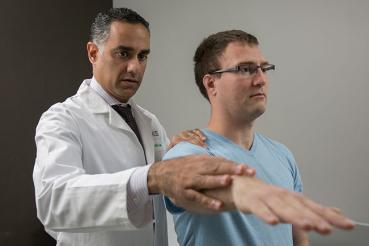There are many misconceptions about osteoporosis. This might be the biggest: It's a disease of aging, the inevitable result of losing bone mass over the years.
"Osteoporosis risk actually begins at birth," says Sanford Baim, MD, a rheumatologist at Rush University Medical Center. "It's a lifelong issue, and you have to think about all of the factors that go into your risk of fractures, from genetics to lifestyle to medical conditions."
While you can't change your family history, you can — and should — take the following steps to protect your bones at every stage of life.
1. Keep tabs on your bone density
Women 65 and older and men 70 and older should get regular bone density tests, or DXA scans. You may need to start earlier if you have an increased risk of osteoporosis-related fractures.
Factors that increase your risk include the following:
- Diseases, including certain cancers and cystic fibrosis
- Chronic health conditions, like diabetes and inflammatory bowel disease (Crohn's disease or ulcerative colitis)
- Use of medications that cause bone loss, such as steroids and certain cancer drugs
- Having a small frame
If you do have a chronic health issue, make sure you are managing it properly. "If you don't control the disease, you increase your risk of complications, including those that can weaken bones," Baim says.
2. Stay strong
One of the worst things you can do for your bones? Be a couch potato.
Like muscles, bones grow weaker if you don't use them. Weight-bearing activities — those that make you work against gravity (e.g., walking, jogging, hiking and tennis) — will help keep both your bones and muscles strong. They will also help you maintain a healthy weight, so there is less stress on your bones.
Even if you have a chronic condition and can't move around as much, you can still engage in bone-boosting activities. Try tai chi, swimming, water exercises, or gentle and modified chair yoga. Ask your doctor to help develop an exercise program around your physical needs.
3. Maintain your balance
In addition to cardiovascular and strengthening activities, mix in some balance exercises. These include walking heel to toe, standing on one foot, back leg raises and side leg raises.
"Balance exercises are often overlooked," Baim says. "But balance is very important for preventing falls in older adults."
4. Get your daily nutrients, including protein
"I always recommend a well-balanced, nutritious diet," Baim says.
In addition to getting the recommended daily allowances of calcium and vitamin D (to help your body absorb calcium), make sure you're eating enough protein. "Protein is related to both bone health and overall health," Baim explains, "including your ability to fight off infection, and recover from injuries and illness."
Talk with your primary care doctor or a dietician if you're not sure which foods to choose or how much protein, calcium and vitamin D are recommended for people in your age group.
Excessive drinking can have a direct poisoning effect on bone cells. This raises the risk of fractures. In fact, chronic alcohol use has been linked to an increase in hip, spine and wrist fractures.
5. Don't smoke
"In addition to harming your heart, lungs and brain, and raising your risk of many types of cancer, smoking is also bad for your bones," Baim says.
Studies have shown a direct relationship between tobacco use and decreased bone density. And smoking has been identified as a risk factor for both osteoporosis and bone fractures, though exactly how smoking affects bone health is not known.
The good news, according to the National Institutes of Health (NIH), is that your bones can benefit from kicking the cigarette habit. Quitting smoking — even later in life — may help limit smoking-related bone loss and fractures.
6. Go easy on the alcohol
Among other harmful effects, excessive drinking can have a direct poisoning effect on bone cells. This raises the risk of fractures. In fact, the NIH reports that chronic alcohol use has been linked to an increase in hip, spine and wrist fractures.
Getting tipsy or drunk can also make you more prone to falls.
That's why Baim advises men to have no more than two drinks per day (that means two ounces of hard alcohol, two six-ounce glasses of wine or two beers); and women to limit themselves to one daily alcoholic beverage.
7. Talk to your doctor about new risk factors
Every time you see your primary care doctor, mention everything that has come up since your last visit that may now put you at increased risk of fractures:
- Balance or vision problems
- Changes in mental status
- Dietary issues or changes (such as loss of appetite)
- New or more frequent falls
- Menopause
- New medications
- A medical condition (such as stroke) or orthopedic injury that has left you unable to move around
Because your health is constantly changing, it's important to bring your doctor up to date. He or she can then work with you to prevent bone loss and damage at every stage of your life.




